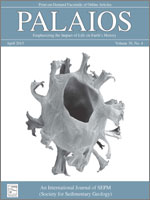Assemblages composed of Heleobia parchappii and H. australis constitute the dominant elements in Quaternary deposits of the Pampean Region in the province of Buenos Aires. This study describes and analyzes the degree of preservation of shells of both species recovered from nine Holocene localities in order to describe and quantify taphonomic alterations, evaluate if preservation varied during the Holocene, and assess their utility as paleoenvironmental bioindicators. Heleobia parchappii displayed better overall preservation than H. australis, with little evidence of fragmentation, limited principally to levels with highest densities. On a temporal scale, no significant differences in fragmentation were found, whereas corrasion and luster displayed temporal differences.
How to translate text using browser tools
1 April 2015
TAPHONOMIC SIGNATURES IN CONCENTRATIONS OF HELEOBIA STIMPSON, 1865 FROM HOLOCENE DEPOSITS OF THE SALADO RIVER BASIN, BUENOS AIRES, ARGENTINA: THEIR UTILITY IN PALEOENVIRONMENTAL RECONSTRUCTIONS
MARIA FLORENCIA PISANO,
CLAUDIO GERMÁN DE FRANCESCO,
ENRIQUE EDUARDO FUCKS
ACCESS THE FULL ARTICLE
It is not available for individual sale.
This article is only available to subscribers.
It is not available for individual sale.
It is not available for individual sale.

PALAIOS
Vol. 30 • No. 4
April 2015
Vol. 30 • No. 4
April 2015




